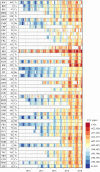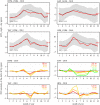The fingerprint of the summer 2018 drought in Europe on ground-based atmospheric CO2 measurements
- PMID: 32892733
- PMCID: PMC7485094
- DOI: 10.1098/rstb.2019.0513
The fingerprint of the summer 2018 drought in Europe on ground-based atmospheric CO2 measurements
Abstract
During the summer of 2018, a widespread drought developed over Northern and Central Europe. The increase in temperature and the reduction of soil moisture have influenced carbon dioxide (CO2) exchange between the atmosphere and terrestrial ecosystems in various ways, such as a reduction of photosynthesis, changes in ecosystem respiration, or allowing more frequent fires. In this study, we characterize the resulting perturbation of the atmospheric CO2 seasonal cycles. 2018 has a good coverage of European regions affected by drought, allowing the investigation of how ecosystem flux anomalies impacted spatial CO2 gradients between stations. This density of stations is unprecedented compared to previous drought events in 2003 and 2015, particularly thanks to the deployment of the Integrated Carbon Observation System (ICOS) network of atmospheric greenhouse gas monitoring stations in recent years. Seasonal CO2 cycles from 48 European stations were available for 2017 and 2018. Earlier data were retrieved for comparison from international databases or national networks. Here, we show that the usual summer minimum in CO2 due to the surface carbon uptake was reduced by 1.4 ppm in 2018 for the 10 stations located in the area most affected by the temperature anomaly, mostly in Northern Europe. Notwithstanding, the CO2 transition phases before and after July were slower in 2018 compared to 2017, suggesting an extension of the growing season, with either continued CO2 uptake by photosynthesis and/or a reduction in respiration driven by the depletion of substrate for respiration inherited from the previous months due to the drought. For stations with sufficiently long time series, the CO2 anomaly observed in 2018 was compared to previous European droughts in 2003 and 2015. Considering the areas most affected by the temperature anomalies, we found a higher CO2 anomaly in 2003 (+3 ppm averaged over 4 sites), and a smaller anomaly in 2015 (+1 ppm averaged over 11 sites) compared to 2018. This article is part of the theme issue 'Impacts of the 2018 severe drought and heatwave in Europe: from site to continental scale'.
Keywords: ICOS; atmospheric CO2 measurements; drought; net ecosystem exchange.
Conflict of interest statement
We declare we have no competing interests.
Figures










References
-
- Ramonet M, et al. 2010. A recent build-up of atmospheric CO2 over Europe. Part 1: observed signals and possible explanations. Tellus B 62, 1–13. (10.1111/j.1600-0889.2009.00442.x) - DOI
-
- Conway TJ, Tans PP. 1999. Development of the CO2 latitude gradient in recent decades. Global Biogeochem. Cycles 13, 821 (10.1029/1999GB900045) - DOI
-
- Dlugokencky EJ, et al. 2009. Observational constraints on recent increases in the atmospheric CH4 burden. Geophys. Res. Lett. 36, L18803 (10.1029/2009gl039780) - DOI
-
- Miller JB, Gatti LV, d'Amelio MTS, Crotwell AM, Dlugokencky EJ, Bakwin P, Artaxo P, Tans PP. 2007. Airborne measurements indicate large methane emissions from the eastern Amazon basin. Geophys. Res. Lett. 34, L10809 (10.1029/2006gl029213) - DOI
-
- Ciais P, Rayner P, Chevallier F, Bousquet P, Logan M, Peylin P, Ramonet M. 2010. Atmospheric inversions for estimating CO2 fluxes: methods and perspectives. Clim. Change 103, 69–92. (10.1007/s10584-010-9909-3) - DOI
Publication types
MeSH terms
Substances
Associated data
LinkOut - more resources
Full Text Sources

